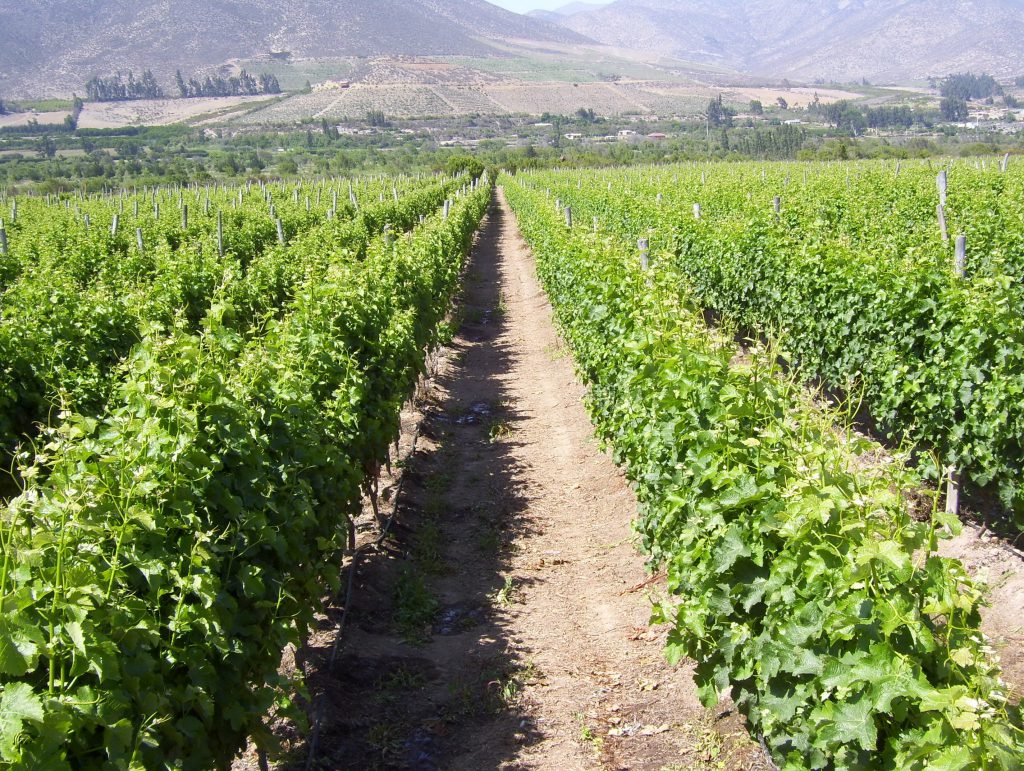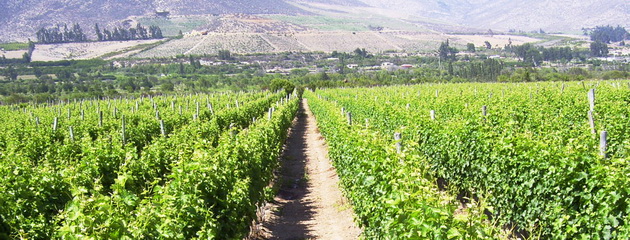
Wine Expert, Rogers Daytime Television

Photo: Tania Thomas
In addition to being one of the oldest and most significant Chilean winery, they are also the biggest exporter, selling their wines on five continents. With over 150 years of winemaking history, Viña San Pedro is a major player in placing Chile on the world map as a producer of top quality, world-class wines.
We were treated to the tasting of their 1865 Single Vineyard portfolio and as a special treat, 2012 Limited Addition Syrah. The fruit for these wines is sourced from high altitude, lower temperature vineyards located at 700 meters above the sea level, producing fruit-forward wines with softer, more complex tannins.

Photo: Tania Thomas
The first wine poured was refreshing, slightly oaked 2015 Chardonnay with great acidity due to partial malolactic fermentation. Following, was Maipo Valley Cabernet Sauvignon, “pretty boy of 1865” as Matias jokingly put it. With soft, velvety tannins, it offers the best expression of Chilean New World style.
Next, came two Carmenere’s from 2014 and 2015 vintages. Both delivered pronounced notes of spice, paprika and white pepper. Easy drinking, approachable wines. And as a special treat, Matias shared 2012 Limited Addition Syrah with us. A beautifully intense and complex wine, crafted with great finesse, rated 95/100 points. That was a real treat indeed and a perfect ending to the great tasting.

Photo: Tania Thomas
The tasting was held in a private studio at Bayward Market’s Andaz Hotel and accompanied by a perfect lunch. Succulent pork loin glazed with apple cider, roasted chicken thighs and peas with smoked bacon juice, finished off with a velvety dark chocolate tart with fresh berries and red wine/berry coulis. Lovely!

Jennifer MacDonald Havers
Wine Columnist, Ottawa Citizen
Our tasting group enjoyed a nice afternoon and the wonderful opportunity to speak to Matias Cruzat, the Enologist and Brand Ambassador with Vina San Pedro out of Chile, about their newest releases. This historic winery celebrates over 150 years of history, and has received some recent accolades, including recognition from Wine Spectator for their 1865 Cabernet Sauvignon (named 59 on their top 100 list) and their 2014 Carmenère which they placed on their best value list. Matias spoke of their history, and commitment to quality, which became evident as we tasted through their portfolio.
Photo: Jenn Havers
One surprising thing about winemaking in Chile is the impressive variability of the climate and the challenges this brings. I think many may assume this South American country is a warm winemaking region, but mountains, altitude, as well as proximity to the ocean of many winemaking areas such in the Elqui Valley all experience moderating factors. Those cool ocean breezes can protect the grapes from overripening and help wines to maintain a crisp acidity which help ensure they are food friendly and, for the whites, crisp and refreshing. Other areas, such as the Maule Valley, grapes such as Carmenère are planted in the well draining alluvial soil of the foothills, ensuring a nice concentration of flavours.
Photo: Jenn Havers
Another surprising thing regarding winemaking in Chile is how the terrain and terroir affects both the winemaking process and the flavours impacting the wine. The mountainous conditions in which winemakers and vineyard staff manage can pose some challenges. Matias talked of transporting the harvest in refrigerated trucks through the mountains for 7 hours to be delivered to the main winemaking facility – talk about precious cargo! The diverse regions within Chile also impart some unique characteristics into their wine, for example the lovely Chardonnay picks up a stony minerality from the soil and some tropical notes, perhaps influenced by the papaya orchards close by.
Photo: Jenn Havers
Our tasting included a sample of their lovely Chardonnay and then moved into the reds – Cabernet Sauvignon, Carmenère, and Syrah. The focus on quality for Vina San Pedro shows beyond their vineyards. The wines we tried all showed care in the winemaking process and we learned they use cold maceration to extract colour and flavour from their Carmenère grapes, resulting in a deeply coloured wine. For their Chardonnay, part of the fermentation occurs in concrete vats to impart a unique flavour and texture and really play up the minerality imparted from the terroir. That juice is blended with other Chardonnay from new and used oak barrels to create their resulting wine, showing incredible balance. That attention to detail was evident across their entire portfolio, and it was a pleasure to enjoy and learn of their wines and techniques.

Gwen Barton
Certified Sommelier
San Pedro 1865- Ottawa Tasting Experience
With a name like 1865, it is not easy to forget the historical origins of this Chilean wine producer. Honoring the founding year of San Pedro, the 1865 series has some wonderful expressions of the grapes grown in this amazing country.
Walking us through the tasting, Enologist, Matias Cruzat shared his extensive knowledge of winemaking and what factors contributes to the unique characteristics of the wines shared with us.
The wines we tasted were of single varietal, and none failed to demonstrate the unique characteristics of their particular regions. Matias spoke to the wonderful geography and climate of Chili that lends itself to growing fabulous grapes and producing amazing wines.
The variability of growing areas is incredible, from the warm valleys to the foothills of the Andes Mountains. The extensive coastal border allows for the moderating influences of the Pacific Ocean.
Matias compared the terroir of many of their vineyards to that of Bordeaux. While some have predominantly silt and clay that have resulted from the marine sediment and river valleys, others are more dessert like with gravel and small stones.
With more than 150 years of wine making under their belt, San Pedro has proven to be one of the most important wineries in the country with a significant export market. Along with Viña Santa Rita and Viña Concha y Toro, these three wineries combine to total approximately 90% of Chilean wine sales for 2015.
All grapes for San Pedro 1865 are handpicked, which, while labour intensive, contributes to the quality of the harvest. While select grapes are able to be chosen, pickers are also able to filter out the additional vine and leaves that may go unnoticed by a harvester.
Hand picking also allows for more delicate handling – a requirement of older vines. Care is also required when transporting to the wine making facilities given the potential for very hot days in the country. Refrigerated trucks are a necessity.
Matias provided a great tasting experience for our group. Thank you – hope you come again.

Jane Staples
Wine Columnist, Ottawa Wedding Magazine
Our team of wine writers recently attended a very polished and informative tasting of Chile’s San Pedro 1865 range of wines. Oenologist Matias Cruzat led the presentation. Matias graduated in Agronomy with a special mention in Viticulture and Winemaking from the Pontificia Universidad Católica de Chile and has significant international experience in the wine business.
We learned that San Pedro has a wine-making history going back 150 years. Viña San Pedro was founded in 1865 by the Correa Albano brothers, who brought Old World varietals to Chile. Today, Viña San Pedro is committed to the environment and uses a variety of practices that are dedicated to sustainable viticulture, as well as a holistic commitment to support for their workers, their families and the communities where San Pedro farms. They are now one of the largest and most important wine exporters in Chile, exporting to over 80 markets on five continents.
We learned about the geography and terroir in Chile’s wine-growing regions. Matias discussed climate, harvest and viticultural processes and we conducted a detailed tasting of five impressive wines.
What I noticed and enjoyed very much was the distinctive flavours and spicing elements used in San Pedro wines, e.g., the papaya flavours in the 1865 Chardonnay 2015. That’s very distinctive amongst all the chards I’ve tried. I also loved the savoury combination of paprika, white pepper and nutmeg in the 1865 Carmenère 2014. These are memorable wines with personality!
By special request, we were treated to a sample of San Pedro’s Limited Edition 2012 Syrah, which was rated 95 points by James Suckling in 2017. Richly aromatic, with a savoury mouth-watering palate, this was another highly distinctive wine. It is an ideal match with “pichanga”, a popular appetizer of pickled vegetables. One of the pleasures of learning about wine is tasting the foods that pair well with each wine.
Although Chile is a long distance from Canada, this informative tasting forged new bonds and made that distance feel just a little bit shorter. There was much talk about a team visit to Chile to further our appreciation for their wines. Let’s hope that dream comes true!
Jane Staples, Accredited Sommelier & Wine Writer
@bellovinoj
San Pedro 1865 Single Vineyard Carmenere 2014
Maule Valley, Chile

Lynn van der Linde
Certified Sommelier and Event Planner
150th …Celebrated Between Two Countries
The year 1865 marked the beginning of a Chilean winemaking legacy, when the Correa Albano brothers established San Pedro Winery. They were innovators on bringing Old World wine varieties to the Elqui Valley in Chile, and capitalized on the perfect wine growing region this special valley has to offer.
More than 150 years later, I had the privilege of meeting San Pedro winemaker, Matías Cruzat, on his inaugural trip to Ottawa – and Canada – to hear him promote the latest gems from his portfolio. Matías is proudly promoting his “flagship” 1865 label created in 2015 to mark 150 years of excellence, and features the best wine from the best vintages… and they are so worth writing home about!
Situated in a modern and open room at the Andaz Hotel Ottawa, there were five wines to sample from the 1865 label. Starting with the 2015 Chardonnay, we then moved to the 2014 Cabernet Sauvignon, then a study across both the 2014 and 2015 vintages of Carmenère, and finishing with the very unique, very special 2012 Syrah.

Photo by Lynn van der Linde
The Elqui Valley is located 25 kms from the Ocean, and in a region that is famous for its dried fruit productions, including figs and papaya. I didn’t know that some of the world’s biggest papaya growers were located in this Chilean valley. Interestingly enough, the aroma of papaya is ever present in the 2015 Chardonnay, the very region where these grapes were grown.
With a brilliant golden hue in the glass, tropical (papaya!) overtones, and hints of oak and vanilla, Matías only used a slight (2%) malolactic fermentation and only five percent new oak in this Chardonnay vinification, to allow the characteristics of the grape to really come through in the final product. Toasty flavours, a luxurious mouthfeel, with a crisp green apple zip mid-palate, and a persistent papaya finish. According to Matías, he would recommend pairing this lively Chardonnay with salmon or ginger dishes.
Matías then poured for us his award winning 2014 Cabernet Sauvignon, touted in 2016 as one of The Top 100 Wines in Wine Spectator for its 2011 vintage. Grapes for this Cabernet Sauvignon were grown in the Maipo Valley, a similar region to Bordeaux in both latitude and alluvial soil composite.
Busting red berry, baking spice (think: cloves and nutmeg) and cedar aromas are brought about by the use of twenty percent oak throughout vinification, of which one only French Oak was used. Those spicy flavours carry through on the palate, which is typical of the Maipo Valley. With prominent cherry and plum fruit, wonderful structure, yet still very elegant, this wine would be perfect with a variety of dishes from tapas to pasta.
We then moved on to a study in both the 2014 and 2015 Carmenère vintages, grown in the consistently warm region of the Maule Valley. I was reminded that the Carmenère grape needs a very warm region to see its potential, as it requires an extended ripening time to balance its naturally acidic characteristic.
The 2014 vintage, however, experienced a slightly smaller grape production as a result of an early spring freeze, but with healthy grapes, and a consistently warm ripening period, the 2014 vintage is very elegant and less robust that its 2015 sibling. Dark ruby in the glass, spicy aromas of front transform to a rich dark fruit berry flavor, with balanced acidity and tannin, making for a wonderful pairing with steak or barbecued fare.
The 2015 vintage does have more structure, a little more austere, and much more characteristic of what the Carmenère grape is known for.
Finally, Matías treated us to a taste of his “most special wine in Chile” the 2012 Syrah. There was so much happening on the nose of this unique wine! Aromas of rosemary, cured meat, olives and a hint of eucalyptus, that convert into flavours of plum, vanilla and cloves, and a persistent spicy finish. Matías suggested pairing this special wine with a charcuterie platter or what Chileans call a Pichanga (or a “messy” dish of meats, and pickled onions, olives, and peppers). Personally, I loved pairing this with the rich chocolate Grenache cake that was served for dessert.

Photo by Lynn van der Linde
More than one hundred and fifty years of innovation has led to the perfection of San Pedro’s grape growing in the Chilean central valley. These five beautiful and unique wines from San Pedro illustrate this excellence in winemaking.
And as Canada gears up to celebrate 150 years as a country of innovation and excellence itself, picking up some of these wines for your Canada Day celebration will be just another reason to celebrate!
Vina San Pedro 1865 Vineyard Limited Edition Syrah 2012
Chile

Absolute elegance describes the Limited Edition 1865 wines of Viña San Pedro. Each of the 1865 varietals and blends was crafted from single vineyard harvests with a clear intention of expressing the uniqueness of Chilean terroirs.1865 is a symbol in itself of the excellence of Chilean terroir for over 150 years.
Our Ottawa team of tasters enjoyed the pleasure of sampling these select Viña San Pedro wines hailing from all across Chile’s prominent wine regions while Viña San Pedro winemaker and enologist, Matías Cruzat, delivered a thorough walk-through on each of Chile’s most prominent and up and coming wine regions.
The northernmost Elqui Valley region – more renown as the Pisco production capital of Chile – showcased a standout 2015 vintage Chardonnay and 2012 vintage Syrah. Both wines were well-favoured amongst our group and well-noted in my reviews for their balance, structure, flavour concentration, body and finish.
Chileans refer to Elqui as the “northernmost frontier of Chilean viticulture” where plantings were only first harvested just over a decade ago. The Elqui Valley begins on the fringes of the Atacama Desert and spreads across northern Chile towards the Pacific Ocean.
With such a strong maritime influence, cool climate, and clayey, mineral rich (Atacama Desert) soils, it’s quite clear how this wine carries such attractive elegance and complexity. Even more fascinating is the work that is put into making wine from this region.
Winemaker Matías Cruzat shared an anecdote of their annual harvesting regiment which includes hand picking the grapes and then having to truck them 700+ kilometres to be vinified at the Viña San Pedro Curico facility.The northernmost Elqui Valley region – more renown as the Pisco production capital of Chile – showcased a standout 2015 vintage Chardonnay and 2012 vintage Syrah.
It is common knowledge now that Carmenere was once mistaken for Merlot, a grape variety that ripens much earlier than Carmenere. Carmenere needs time develop phenolic fruit ripeness – i.e. ripeness of fruit flavours – because it is a grape varietal with the highest levels of pyrazine compounds (undesirable vegetal characteristics in wine).
Matías describes that being patient pays and with the right soils and microclimate in their Maule vineyards, it is quite possibly the answer to how their Carmenere is so remarkable.
Finally, we made our way to the historical heart of Chilean viticulture – the dry, the stony and loose clay, warm-Mediterranean climate, Maipo Valley terroir. A place well-known for big bold red wines. The 2015 vintage 1865 Cabernet Sauvignon was received with 91+ point reviews all around and astounding appreciation for its value for the quality.
What I found most fascinating was how nearly all of these vast and varying regions showed such an expressive elegance in these 1865 wines. Enjoy!
Casablanca Valley, Chile

Pam Chiles
Wine & Food Blogger
Vina San Pedro is a venerable old Chilean winery, established in 1865, and famous for producing Gato Negro, the wildly successful red wine (they say 2 bottles are uncorked every second around the world!) They produce several brands of wine and today, with winemaker Matias Cruzat leading the tasting, we were treated to the “1865” range – their top-notch, single-vineyard, multi-award-winning range.
San Pedro has almost 3000 hectares of vineyards in all the major wine-growing regions of Chile, from the Elqui Valley in the north to Bio-Bio Valley in the south. Wine regions are influenced by a number of factors, including proximity to the mountains and ocean, elevation, local geography and of course soils.
Matias is particularly fond of the Elqui Valley wines, which included the 2015 Chardonnay and 2015 Syrah in this tasting. The valley is the northernmost wine growing region in the country and makes rare, “boutique” or very limited production wines.
We also tasted the 2014 Cabernet Sauvignon from the Maipo Valley and two vintages of Carmenere (2014 and 2015) from the Maule Valley. Both valleys are well-known, vast, wine-growing areas in Chile, however these three wines are made from grapes from single vineyards, showcasing the best within each region. Notable, the Cabernet Sauvignon and Carmenere from 2014 both made the Wine Spectator “Top 100” lists (Top 100 and Top 100 Value)
We learned from Matias that harvest time in Chile starts in February in Elqui and stretches to May in the southern vineyards of the Bio-Bio valley, and of course is further complicated by the ripening of different grape varieties at different times – quite a feat of logistics and planning. The ripening order is generally: Chardonnay, Cabernet Sauvignon, Carmenere, then Syrah. Grapes are all processed at San Pedro’s main facility south of Santiago.
The wines of the 1865 range are very enjoyable, food-friendly, well-crafted with lots of flavour and good structure. And the price point is friendly too – around $20.
Thanks to Matias Cruzat and San Pedro for an enjoyable tasting and the crew at Andaz for great food and service as usual!
San Pedro 1865 Single Vineyard Carmenere 2015
Maule Valley, Chile

Simon Chen
University of Ottawa , Ottawa
New Winemaker Luncheon and Tasting with Matias Cruzat
Another fantastic winemaker lunch with Natalie’s tasting group at Andaz. We had the opportunity to meet with a very young talented winemaker, Mattas Cruzat, from Chile. Mattias is the winemaker for the ‘1865 Single Vineyard’ portfolio and it is part of the Vina San Pedro’s team that has 150 years of history.
The idea of this series is to produce amazing wines from different old-vine vineyards in Chile and to reveal the unique characteristics of each region and each grape varietal. And this is exactly what we tasted in the glass today.
I learned that because Chile is narrow and long like a scarf, wine regions that span the country can produce completely different styles of wines.
We started off with their single vineyard Chardonnay from the 2015 vintage. The grape is sourced from the Elqui Valley, which is in northern Chile and 2 hours by plane from Santiago.
Naively, I thought Chile, in general, is hot, so it’s good for grape varietals like Cabernet or Carmenere. However, Matias told us because this region is in the north of Chile, it is cooler and has dessert-like climate, and it’s perfect for growing chardonnay, pinot noir, and syrah.
The Chardonnay is simply amazing. It’s bright, crisp, and has the right amount of acidity to balance the bitterness of the chardonnay.
We also tried their 2012 limited edition Syrah from the Elqui valley. 2012 is considered an OK vintage due to the hot weather there that year.
However, because Elqui valley is so north, their syrah exhibits elegant structure and roundness fruits. The wine also has a unique aroma of olive, salami, and white pepper.
The second wine that we tasted was their 2014 single vineyard cabernet sauvignon from the Maipo Valley. This region is part of the Central Valley, and is south of Santiago. It is warm during the day and cold at night and is ideal for Cabernet Sauvignon.
The wine is more toward old-bordeaux style that has classical black currant, vegetale, fruit and smooth tannin. This 2012 Cabernet was selected as one of the Top 100 wines by Wine Spectator in 2016.
Lastly, we had the opportunity to do a mini vertical of their 2014 and 2015 Carmenere from Maule Valley. Maule Valley is also part of the Central Valley and it’s the most Southern wine region that we tasted today.
It is indeed interesting to try both wines side by side. 2014 is a good year but had smaller yield. The wine is leaner, vegetal but has very good smooth tannin and lingering aftertaste. However, 15 is rich and round but still has the greenness note from Carmenere.
San Pedro 1865 Single Vineyard Cabernet Sauvignon 2014
Rapel Valley, Chile
Viña San Pedro has been creating wines in Chile for almost one hundred and fifty years. A pioneer in the past and a present-day innovator in the New World, it has helped in building an industry from Elqui to Bío-Bío.
Founded in year 1865, Viña San Pedro is nowadays one of the largest and oldest exporters of Chilean wine and one of the most important wineries in the country.
San Pedro’s main vineyard, wine cellar and hundred-year-old underground cava cellar are located in Molina, in Curicó Valley, 200 Km. south of Santiago. There, San Pedro has one of the largest stretches of vineyards in Latin America, with 1,200 hectares.
Parallelly, San Pedro has over 1,500 planted hectares in Central Valley and in the other main vine-growing valleys in Chile, such as Elqui, Casablanca, San Antonio-Leyda, Maipo, Cachapoal, Maule and Bío-Bío, always in the quest for new and better origins for its wines.
Viña San Pedro is part of the so-called VSPT Wine Group winemaking group, the third largest vitivinicultural group in Chile and the second largest exporter of Chilean wine.
Its portfolio includes the brands Cabo de Hornos, Kankana del Elqui, Tierras Moradas, 1865 Single Vineyard, 1865 Lmited Edition, Castillo de Molina, 35 South and GatoNegro, which enjoy vibrant success in the most competitive markets.
 Matías Cruzat – ENOLOGIST, 1865 SINGLE VINEYARD AND CASTILLO DE MOLINA
Matías Cruzat – ENOLOGIST, 1865 SINGLE VINEYARD AND CASTILLO DE MOLINA


































